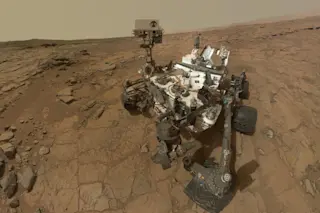Curiosity's self portrait on Mars. Image courtesy of NASA/JPL-Caltech/MSSS While Curiosity's primary mission was to find out if Mars might ever have been capable of supporting Martian life, the rover has also collected data pertinent for a different kind of life: human beings. Curiosity has kept tabs on radiation levels on Mars as well as during the 253-day, 350-million-mile trip it took to get there. Findings released today indicate that radiation levels an astronaut would receive from a trip to Mars and back would be high: approximately 2/3 of their lifetime recommended dosage. Space travelers outside of Earth’s life-friendly atmosphere and magnetic field have to contend with a serious dose of two kinds of harmful radiation: galactic cosmic rays, which are basically everywhere in space, and solar energetic particles, which arise from activity on the sun. The former would present a constant low dose, with particles energetic enough to penetrate ...
Astronauts Would Face High Radiation on Manned Mars Mission
Curiosity Mars mission reveals high radiation levels for astronauts, posing challenges for future manned missions to Mars.
More on Discover
Stay Curious
SubscribeTo The Magazine
Save up to 40% off the cover price when you subscribe to Discover magazine.
Subscribe













